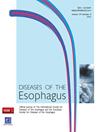254.量化反流手术和裂孔疝手术的围手术期风险:一项针对 4301 名患者的多中心队列研究
IF 2.3
3区 医学
Q3 GASTROENTEROLOGY & HEPATOLOGY
引用次数: 0
摘要
背景预测胃底折叠术和裂孔疝修补术的围手术期风险将为治疗决策、医院资源分配和基准制定提供依据。然而,现有的风险计算器在估算围手术期风险时并未考虑疝的解剖结构或手术技术方面的因素。我们利用一个全面的澳大利亚队列,量化了与反流和裂孔疝手术相关的术中和术后并发症的发生率,并确定了独立的预测因素。此外,我们还进行了深入分析,以了解与每个独立风险因素相关的并发症概况。方法 对澳大利亚 36 家医院 10 年来的所有选择性反流和裂孔疝手术进行回顾性分析。考虑到患者、手术、解剖和围手术期因素,进行了层次多变量逻辑回归分析,以确定术中和术后并发症的独立预测因素。结果 共分析了 4301 例手术。其中,1569 例(36.5%)为巨大疝,292 例(6.8%)为翻修手术。术中和术后并发症的发生率分别为 12.6% 和 13.3%。夏尔森综合症指数、疝气大小、翻修手术和基线抗凝剂使用情况可独立预测术中和术后并发症。这些风险因素都与各自的并发症情况有关。最后,通过风险矩阵,我们直观地看到了这四个风险因素对术中、术后总体和术后主要并发症的累积影响。结论 本研究加深了我们对与反流手术和裂孔疝手术相关的围手术期发病率的了解。我们的研究结果根据围手术期风险对患者进行了分组,为个人和机构层面的护理提供了参考。本文章由计算机程序翻译,如有差异,请以英文原文为准。
254. QUANTIFYING PERIOPERATIVE RISKS FOR ANTIREFLUX AND HIATUS HERNIA SURGERY: A MULTICENTER COHORT STUDY OF 4301 PATIENTS
Background Predicting perioperative risks for fundoplication and hiatus hernia repair will inform treatment decision-making, hospital resource allocation, and benchmarking. However, available risk calculators do not account for hernia anatomy or technical aspects of surgery in estimating perioperative risk. Using a comprehensive Australian cohort, we quantified the incidence and determined the independent predictors of intraoperative and postoperative complications associated with antireflux and hiatus hernia surgeries. Additionally, we performed an in-depth analysis to understand the complication profiles associated with each independent risk factor. Methods Retrospective analysis of all elective antireflux and hiatus hernia surgeries in 36 Australian hospitals over 10 years. Hierarchical multivariate logistic regression analyses were performed to determine the independent predictors of intraoperative and postoperative complications accounting for patient, surgical, anatomical, and perioperative factors. Results A total of 4301 surgeries were analyzed. Of these, 1569 (36.5%) were large/giant hernias and 292 (6.8%) were revisional procedures. The incidence rates of intra- and postoperative complications were 12.6% and 13.3%, respectively. The Charlson Comorbidity Index, hernia size, revisional surgery, and baseline anticoagulant usage independently predicted both intraoperative and postoperative complications. These risk factors were associated with their own complication profiles. Finally, using risk matrices, we visualized the cumulative impact of these four risk factors have on the development of intraoperative, overall postoperative, and major postoperative complications. Conclusions This study has improved our understanding of perioperative morbidity associated with antireflux and hiatus hernia surgery. Our findings group patients along a spectrum of perioperative risks that informs care at an individual and institutional level.
求助全文
通过发布文献求助,成功后即可免费获取论文全文。
去求助
来源期刊

Diseases of the Esophagus
医学-胃肠肝病学
CiteScore
5.30
自引率
7.70%
发文量
568
审稿时长
6 months
期刊介绍:
Diseases of the Esophagus covers all aspects of the esophagus - etiology, investigation and diagnosis, and both medical and surgical treatment.
 求助内容:
求助内容: 应助结果提醒方式:
应助结果提醒方式:


